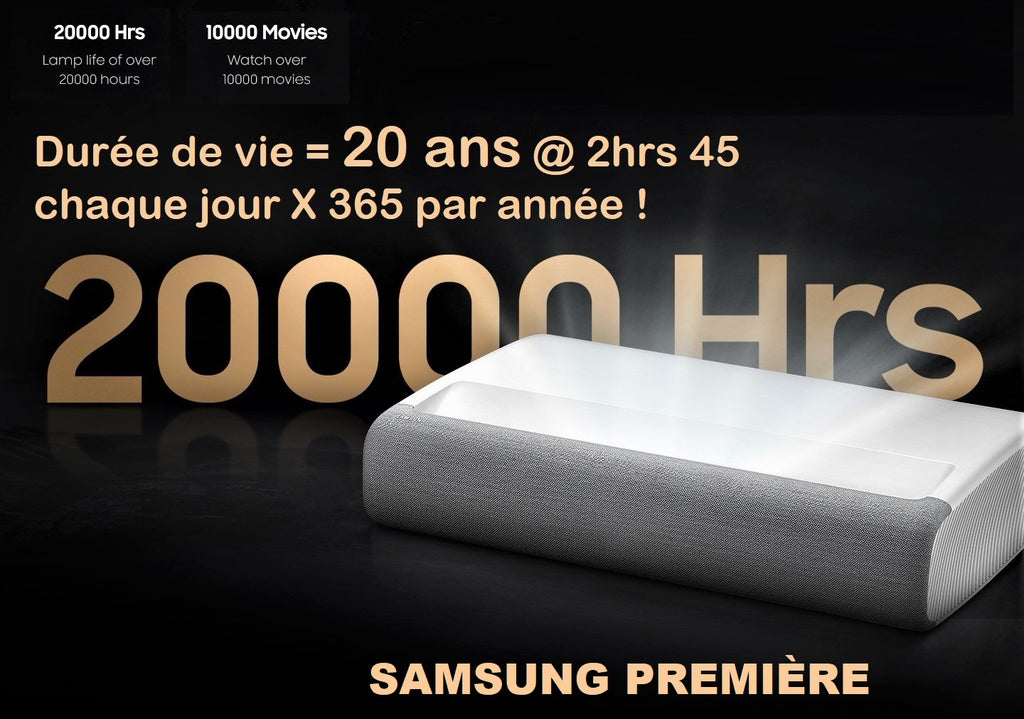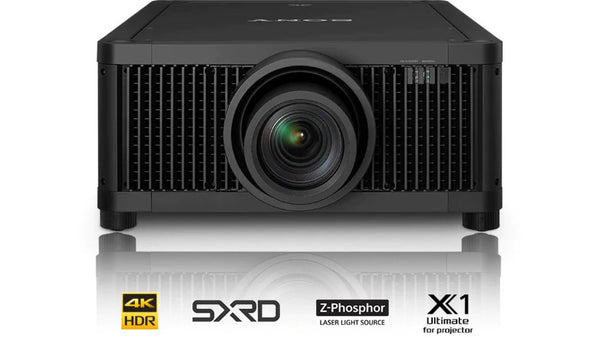
Projected screen TVs. The pluses (+) and minuses (-) ...
Just 20 years ago, the best-selling TV format was the 27-inch square tube screen...
The "big" screens for the TV enthusiast used to be a Lilliputian 32 or even 36 inches! Times have changed, because year after year, people are buying more and more large TV sets, and the 75 and 85 inch sizes are selling well these days.

For as long as I can remember, there has been one type of screen that remains in vogue and is even increasingly coveted, the TV projector. They have been selling in increasing numbers since the 1970s! Just like the rest of the television products, the projector has been stagnant in its evolution for a good part of its marketing, but just like the classic TVs, it is now moving forward at great speed, so that the projection currently offers a performance approaching the standard TV, but with such a remarkable presence!
Let me explain the different concepts and inform you about what makes a good projector and a bad one.
History of technologies.
70-80 In the early days of consumer projectors, 3 cathode ray tubes were used, directed towards a system of magnifiers and mirrors to reproduce the image. The lifespan was short, the luminosity low and the degradation of the images generated very fast, sometimes in only one year...

90-2000 In 1994, manufacturers switched to liquid crystal panels backlit by a metal vapour lamp. This new concept almost completely eliminated image marking, intense heat from the device for longer life and superior brightness. Definitely an improvement over CRTs (tubes), colour quality and contrast could still be improved.
2000 to today. DLP for Digital Light Processing was born at the turn of the century. Developed by Texas Instruments, the DLP chip is an assembly of millions of micro-mirrors that direct the light flow towards the screen and, in the case of darkness, towards an absorption material called a "light dump".
To direct the right pixels to the right mirrors, a colour filter wheel was initially used which rotated in time with the creation of the image. This principle was not recommended for people suffering from epilepsy in particular, and many people perceived the flickering of the image created by the rainbow vision when they moved their heads. The gains of this principle were higher brightness, more intense colours, image generation impossible to damage by marking. On the weak side: colour streaking of moving images, or "rainbow" effect. Flicker, which is harmful to some.
Nowadays, all the constraints have been addressed by the use of 3 chips corresponding to the 3 primary colours "red green and blue", a prism decomposes the image illuminated by the light source, the full range of theoretical colours is in the billions which allows a very detailed image.
All new designs since the abandonment of CRTs require a light source, whether of the high-intensity or laser type.  Samsung First Laser Projector
Samsung First Laser Projector
What you need to know to compare :
Now that you understand the principles of operation, it is important to know that the result is not the same from one model to another. For the same price, the performance will vary for different factors, including the following:
Resolution :
Just like standard TV sets, there are now two types of image resolution. Full HD using 1080 x 1920 dots or pixels which is gradually being replaced by the second, 4K which offers more, 2160 by 3840 pixels. Because the image is so large, I would not recommend buying Full HD, as you will see limitations in the accuracy of the images, including a grainy image
Brightness :
This is important to watch out for, as the lower the brightness, the more you will have to watch the image than in the dark. In the past we had no choice, but nowadays good projectors allow for daylight viewing. Brightness is measured in LUMENS. Below a factor of 1000 will be clearly insufficient and can only be found in cheap projectors, ideally I advise a factor of 2000 and more which will allow daylight viewing and less constraints in general use.  EPSON 5050be
EPSON 5050be
Contrast ratio and HDR
A bright, but non-contrasting image is the equivalent of lighting without more, a big lamp in the room! If dark and bright shapes are not differentiated, you will see little detail, only the brightness...
Contrast is divided into two ratios, "native" and "dynamic". For example, assuming a ratio of 1500:1 "native" means that the brightest image will be 1500 times more intense than the lower limit just before the black point. This ratio delimits the physical capacity of the matrix. The second ratio is called "dynamic" and highlights the result of the brightness in a dark room. This ratio takes into account the result of the many technologies used to enhance image quality and dynamism. Among these technologies,
Variable backlighting to adapt the brightness to the scene being projected. The HDR (high dynamic range) certified circuits greatly enhance the contrast of the final rendering. This kind of ratio is in the 30,000 to 1 range in budget models and exceeds 1 million to 1 on the best units!
The contrast with the accuracy of the colourimetry is the key to a realistic representation, an image that we recognise from what we see in everyday life. I call this the wow factor in projection! The HDR standard is a must!
Colorimetric rate or colour space.
A colour space is a set of colours, also called a gamut. The gamut of a screen or video monitor represents all the colours it is capable of displaying.
It is sometimes expressed as a percentage versus a standard that was first established by the film industry, but is now used by manufacturers of television products. This normative standard is called DCI-P3. Of course, it is important to get as close as possible to this standard and it is preferable to aim for 100%. The better the colour nuances are reproduced, the more you will be able to discern the richness of the hues, the transparency effect, the pearlescent, full tone or pastel colours.
We will thus avoid the fluorescent or candy colours found in second-rate products...
Distance of use.
There are two principles of projection, the "standard", which requires mounting 10 feet or more from the screen on the wall, and the "short throw", which is movable and used within a few inches of the screen.
If it were up to me, I would only make short-throw projectors. New products of this kind allow the projector to be placed only a few inches from the screen. This means you don't have to do the fixed ceiling installation, no wires to run through the walls, the sound comes from the front and not the back. People moving around never conflict with the image (shading) and this gives you the ability to store the projector when not in use.  SAMSUNG FIRST short range laser.
SAMSUNG FIRST short range laser.
Speakers and Bluetooth.
Believe it or not, there are still projectors that only project the picture, forcing you to turn on your sound system or sound bar to listen to your shows!
Easy to install.
It will be interesting to see if the device you are looking for has automatic settings and an on-screen guide that is easy to operate and understand. Unfortunately, I cannot advise you here, it will be the job of your sales consultant to demonstrate this to you.
The initial adjustment should only require a few steps. Having a manual adjustment button on the projector means you don't have to go to the menu to change your adjustments. Automatic adjustment offers an even greater advantage, allowing instant alignment without the need for user control of any kind. Most projectors have some degree of adjustment, but some are more advanced than others. Here are the adjustments required to get the most out of your projector:
Horizontal and vertical keystone correction.
When a projector is not centred directly in front of the screen, but tilted towards it, the resulting image will be distorted into a trapezoidal shape (flared towards the top and bottom sides). However, the keystone correction will correct this so that the image is perfectly rectangular. This can be done manually or automatically.
With automatic keystone correction, the projector will automatically detect and correct the distorted image, simply by pressing a button on the device or the remote control or a mobile device app! A vertical keystone correction aligns the distortion to the top or bottom of the image, and a horizontal keystone correction aligns the distortion to the left or right side.
Lens shift. (focus)
The lens shift allows the lens to move vertically or horizontally within the projector to provide a perfect, straight-edged image with uniform focus. This allows more flexible installation options and placement for the projector without loss of resolution. In the past, this setting was subject to spot misalignment and the lens had to be manually rotated to remove the blur in the image.
Again, look for auto focus.
MAINTENANCE INTERVAL, LAMP DURATION.
Yes, I used capital letters to emphasise how important this factor is!
The lighting system should last a very long time to avoid frustration and costly use. A lamp with a life of 3000 to 5000 hours is a bare minimum. Be aware that a lamp does not produce a uniform glow consistently over time, it degrades and weakens gradually, which is why the new laser technology with its 20,000 hour life should be favoured in your choice. In terms of safety, it is good to know that laser lighting is safe, as it incorporates a presence detection system in front of its light projection that interrupts the light flow in the event of a dazzling hazard. They have thought of everything!
Price to be paid.
As with anything, the price usually goes with the expected result.
Less than $1500 will get you a low output projector, that's how it is.
Between $1,501 and $4,000 spent, you can get 4K performance and an acceptable brightness and contrast ratio.
The best value will be found in the $4001 to $8000 family of products. This is where you'll find the most automation, HDR and DCI-P3 certification, a 20,000 hour life span for the laser transmitter, and the new short throw principle of the projector. While these features can be found in less expensive devices, here you get the whole package in one device.
As for the $10,000 and up, we'll get into the specialization, depending on how important it is to you to have a movie theatre in your home. Most people won't go there.  Sony Specialty Brightness 10,000 lumens $85,000
Sony Specialty Brightness 10,000 lumens $85,000
The last word.
Given the amount of information in this article I will summarise the main points for you.
In summary:
- Set yourself a realistic budget for what you are looking for.
- Prefer a three-chip system rather than a one-chip system, as this will affect the veracity of the colours.
- Demand DCI-P3 compliance for 100% colour gamut and HDR for high contrast for better object distinction.
- Look for a brightness level of 1500 Lumens or more for daytime use. Ideally, 2500 is a "must" for everyday listening.
- Maintenance-free life: The laser is preferable with its 20,000 hours.
- Projection principle. The short throw is preferable, as it allows for easy and flexible installation.
- Automation of settings.
That will do it, next blog post: Projector Screens.
Stay tuned!
Christian.  Choice from the Sonxplus team. Samsung LSP-9T
Choice from the Sonxplus team. Samsung LSP-9T

Leave a comment